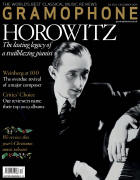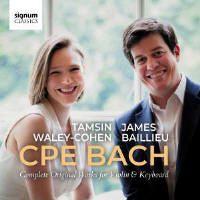Texte paru dans: / Appeared in: |
|
 |
Outil de traduction (Très approximatif) |
|
Reviewer: Mark Seow Contrary to the suggestion of its title, Daniel Dennett’s book From Bacteria to Bach and Back: The Evolution of Minds hardly discusses Bach at all. But the composer’s name is not there just for alliteration or pun. Bach has become a symbol of genius, the apex of human endeavour; the very furthest from a unicellular organism that we can get. It is with this currency that the New York Times was able to run two articles earlier this year entitled ‘Saturdays in the Bronx with Bach’ and ‘Yo-Yo Ma Wants Bach to Save the World’. Bach’s name has become a signifier for social miracle, purportedly possessing the power to mend political division and rebalance racial inequality. But the Bach that these writers refer to is, of course, Johann Sebastian. His sons rarely get a look-in. This three-disc set from Tamsin Waley-Cohen and James Baillieu of the complete works for violin and keyboard by Carl Philipp Emanuel Bach nudges us in the right direction. What we discover – immediately and sustained for 153 minutes and 12 seconds – is that CPE not only does justice to his father but also is a superb composer in his own right. We would do well to remember that for most of the 18th century, talk of ‘the great Bach’ referred to CPE and not JS. Not much work has gone into organising the sonatas. They are presented in chronological order – or at least in order of their ‘Wq’ numbers, the catalogue system established by Alfred Wotquenne in 1905 (it has since fallen out of favour, to be superseded by the ‘H number’ system). As a result, the listening experience tracks the chapters of CPE’s life, a journey which moves from the allant to the strange, experimental fantasia genre via Sturm und Drang. And yet, by serendipity, each disc has a stunning ‘opener’, disclosing a sound world perfect unto itself. Baillieu’s touch in the Adagio ma non molto of the opening D major Sonata (Wq71 H502) is something remarkable. His lines are full of breath, intimate and expansive, shaped with a microscopic sensitivity. Trills glisten over Waley-Cohen, the perfect partner to transform this into bowed song. WaleyCohen’s achievement of pure legato is wondrous (though an unnecessary ornament disrupts the otherwise impeccably sustained broadness and reciprocity of counterpoint) and her sound is tinged with golden frailty. And though this sound world speaks of something more like a serene Schwanengesang than it does of a work by a hormonal teenager – CPE was only 17 years old when he composed the first three sonatas – it thoroughly works. My knees go weak at how the pair navigate the interrupted cadence towards the end of the movement, a gesture which spins out into nostalgic arioso and an ending of exquisite vulnerability. That’s the first movement of 27. We’re also treated to a sublime Largo in the Sonata in B flat (Wq77 H513): Waley Cohen transforms melancholy into sumptuous heartbreak, a moment of F major where the earth stops spinning for an appoggiatura – a ‘but I love you’ – and then tries to resume life as it was, but knows in meandering melody that it simply can’t once those words have been spoken. The loveliness is unceasing. The Arioso theme of the Variations in A (Wq79 H535) is enough to unharden the most hardened of hearts – and these eight bars alone make the entire listening experience worth it. Baillieu’s rhythmic variation in the repeat is lined with thoughtfulness and honesty, the subtlest smell of inégale lingers over his unravelling quavers, while Waley-Cohen purrs beneath with con sordino velvet. Three discs of wonderful music-making, enough to make any father proud.
Gramophone talks to Tamsin Waley-Cohen - The intreprid violinist discusses the music of CPE Bach, having recorded all of the violinand-keyboard works with pianist James Baillieu.
What drew you to the music of CPE Bach?
Some years ago I kept coming across the music of CPE Bach on concert programmes, which piqued my interest, and I began to look into his music and his life. I listened to some recordings and was enthralled by the freedom and expressive range of his music.
Did you decide from the outset
to record the complete works for violin and piano?
This music seems to open up a wealth of expressive possibilities – is it This music seems to open up a wealth of expressive possibilities – Indeed, the greatest challenge of this music for me was to free my mind of the Baroque or Classical constraints of structure that we are all thoroughly trained in! James and I discussed the improvisatory qualities of the music extensively, and we aimed to maintain this in the recording studio as well. Of course, in the end, only one version can go on the disc! The rule book has been completely thrown out by Bach: phrase lengths are irregular and harmonic modulations often unexpected, and even quite wild. For me, this encapsulates the Enlightenment philosophy that CPE Bach was heavily involved with. Free will reigns supreme and the individual is given the highest value. Indeed, the greatest challenge of this music for me was to free my mind of the Baroque or Classical constraints of structure that we are all thoroughly trained in! James and I discussed the improvisatory qualities of the music extensively, and we aimed to maintain this in the recording studio as well. Of course, in the end, only one version can go on the disc! Are there any difficulties with instrumental balance when playing this music?
Because we both use modern instruments – well, my violin is 300 years old, but the set-up is modern – balance was not really an issue. Of course, most of the time, the keyboard is prima voce. The violin’s role is often to support from within, or catching the phrases of the piano, which is extremely fun! I also learnt a great deal about how to create a successful inner line, which is hugely valuable to a violinist who is often the soprano part. Of course, using modern instruments affected the type of balance as a modern piano has a greater range than a harpsichord, for example, and given CPE Bach’s extraordinary dynamic markings as well as his well documented fascination with the development of the keyboard, we felt that he would have enjoyed the possibilities the modern instrument offers.
|
|




